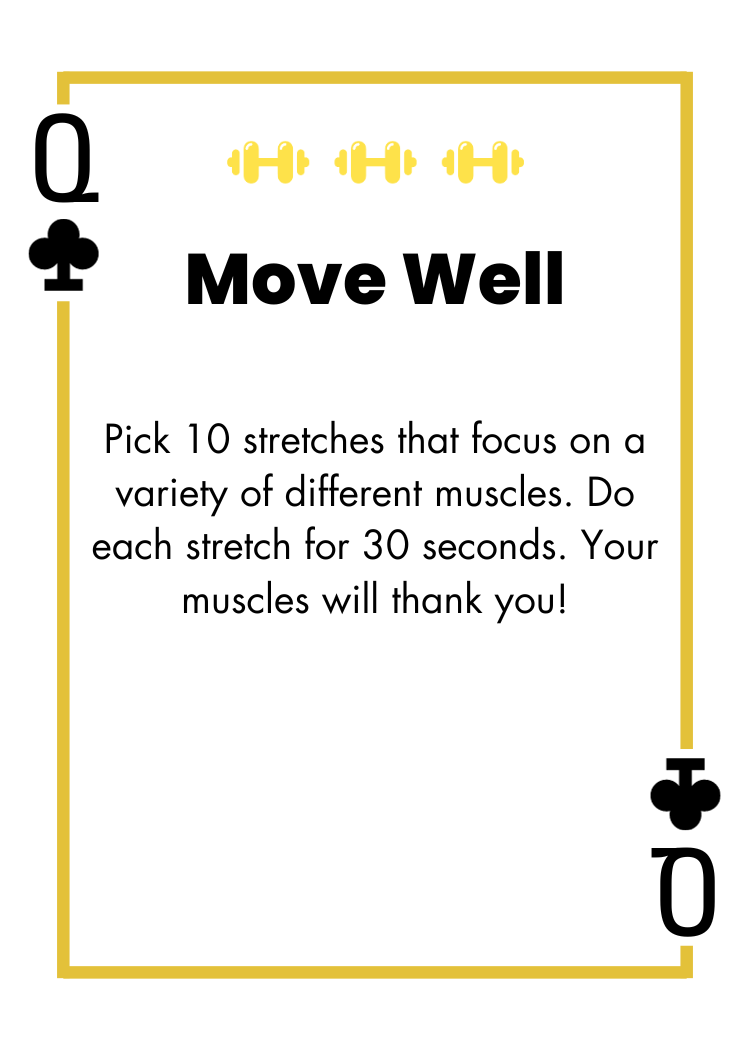Queen of Clubs - Stretching

What is it?
Stretching for exercise is the process of positioning the limbs of the body in ways that will lengthen the muscles and surrounding soft tissue. Stretching can be performed with either of the two basic types of stretching- static and dynamic stretching (Caffrey, 2023).
Apart from the obvious benefits of increased flexibility and range of motion of the joints, stretching increases blood flow, improves your performance in physical activity and improves your posture, all great things!
A greater blood flow helps you to relax, and that feels great, especially when it also helps you recover from soreness and stiffness.
Stuck for ideas on what, where and how to stretch? Ask our physical activity experts – sign up today!

How to do it?
Stretching is divided into two basic types: static stretching and dynamic stretching. A static stretch is a stretch where a person gets into the stretch position and holds it for a set amount of time. By holding the position, places a gradual tension on the muscle during the stretch. This type of stretch is often recommended for beginners or individuals who are not regularly physically active. Static stretches may include passive stretching, active stretching, and isometric stretching. (Caffrey, 2023).
Passive stretching involves the assistance of another individual or tool with the movement of a limb to produce a stretch. Next, active stretching is the activation of muscle strength to create a stretch in a specific area. An example would be raising the leg high in the air and keeping it there without external assistance. Isometric stretches are passive stretches that lengthen muscles for a greater amount of time with higher intensity. (Caffrey, 2023).
Dynamic stretches involve both stretching and movement. During the stretch of a specific part of the body, an individual also swings or bounces the body part to extend its range of motion. The force of the bouncing or swinging creates greater flexibility in the limb and can also work to strengthen muscles. This type of stretching is more beneficial to individuals who are regularly active (Caffrey, 2023).
Correct technique is an important component of stretching. Stretching can cause serious damage to the body if performed incorrectly. Individuals should pay attention to their bodies when performing any physical activity. Any movement or stretch causing pain or serious discomfort should be avoided. Moreover, an individual should never stretch an injured area of the body until the area has recovered and/or the individual has been cleared by a physician to perform the activity.
Warming up is also very important prior to stretching. Stretching cold muscles can lead to muscle damage. Body heat loosens muscles, making them more pliable for stretching. Warm-ups also increase blood flow and release more oxygen into a person’s system, nourishing the muscles (Caffrey, 2023).
American College of Sports Medicine (2011) recommends two to three days a week of stretching to improve joint range of motion.
Why do it?
Continual stretching over long periods of time leads to many benefits. Stretching helps to build muscle elasticity, and tone and promotes increased flexibility. In addition, stretching increases the range of motion, improves circulation, relieves muscle soreness, and reduces overall fatigue. Expert opinion differs on whether stretching before exercise is beneficial, but the majority agree stretching after a workout is vital to muscle recovery (Caffrey, 2023). Long-term stretching can be also beneficial for athletic performance. The mechanism by which regular long-term stretching improves athletic performance is likely related to stretch-induced hypertrophy (Shrier, 2004). Both passive and active stretching techniques have been shown to increase both chronic and acute range of motion (Lima et al., 2019).
What’s the science behind it?
When an individual stretches their body, many things occur within muscles and soft tissue. A muscle is composed of thousands of tiny stringlike cells called muscle fibres. Muscle fibres are packed together within a muscle and the fibres themselves are made up of thousands of smaller threads called myofibrils. This allows the muscles to lengthen, relax, and contract. Contained inside the myofibrils are millions of minuscule bands called sarcomeres. Sarcomeres are made up of overlapping strands of 3 different sized proteins called myofilaments. Stretching a muscle extends and narrows the muscle fibres. As a muscle length increases during a stretch, the connective tissue and sheath of the muscle tendons elongate. As the body gets adapted to stretching, the surrounding ligaments, tendons, connective tissue, skin, and scar tissue also begin to adapt (Caffrey, 2023).
Do you want to know more?
https://exrx.net/ExInfo/Stretching
http://www.mayoclinic.org/healthy-living/fitness/in-depth/stretching/art-20047931
Small changes CAN make a big difference. That’s what The 1% Club is all about.
References
Caffrey, C. (2023). Stretching. Salem Press Encyclopedia of Health.
Garber, C. E., Blissmer, B., Deschenes, M. R., Franklin, B. A., Lamonte, M. J., Lee, I. M., Nieman, D. C., Swain, D. P., and American College of Sports Medicine (2011). American College of Sports Medicine position stand. Quantity and quality of exercise for developing and maintaining cardiorespiratory, musculoskeletal, and neuromotor fitness in apparently healthy adults: guidance for prescribing exercise. Medicine and science in sports and exercise, 43(7), 1334–1359. https://doi.org/10.1249/MSS.0b013e318213fefb
Lima, C. D., Ruas, C. V., Behm, D. G., and Brown, L. E. (2019). Acute effects of stretching on flexibility and performance: a narrative review. Journal of Science in Sport and Exercise, 1, 29-37.
Shrier, I. (2004). Does stretching improve performance?: A systematic and critical review of the literature. Clinical journal of sport medicine, 14(5), 267-273.
Stretching and flexibility. ExRx.net: Exercise Prescription on Internet. (n.d.). https://exrx.net/ExInfo/Stretching
“Stretching: Focus on Flexibility.” Mayo Clinic. Mayo Foundation for Medical Education and Research. Web. 23 Mar. 2015. http://www.mayoclinic.org/healthy-living/fitness/in-depth/stretching/art-20047931

 See Other Cards!
See Other Cards!